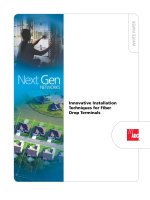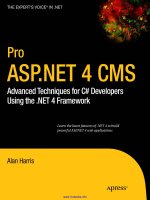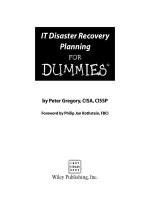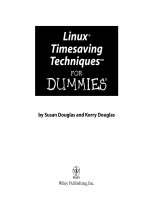IT training rapid techniques for mapping experiences khotailieu
Bạn đang xem bản rút gọn của tài liệu. Xem và tải ngay bản đầy đủ của tài liệu tại đây (16.43 MB, 47 trang )
Rapid Techniques for
Mapping Experiences
Jim Kalbach
Beijing
Boston Farnham Sebastopol
Tokyo
Rapid Techniques for Mapping Experiences
by Jim Kalbach
Copyright © 2017 O’Reilly Media, Inc. All rights reserved.
Printed in the United States of America.
Published by O’Reilly Media, Inc., 1005 Gravenstein Highway North, Sebastopol, CA
95472.
O’Reilly books may be purchased for educational, business, or sales promotional use.
Online editions are also available for most titles ( For more
information, contact our corporate/institutional sales department: 800-998-9938 or
Editor: Angela Rufino
Production Editor: Colleen Cole
Copyeditor: Octal Publishing, Inc.
December 2016:
Interior Designer: David Futato
Cover Designer: Karen Montgomery
Illustrator: Rebecca Demarest
First Edition
Revision History for the First Edition
2016-12-22:
First Release
The O’Reilly logo is a registered trademark of O’Reilly Media, Inc. Rapid Techniques
for Mapping Experiences, the cover image, and related trade dress are trademarks of
O’Reilly Media, Inc.
While the publisher and the author have used good faith efforts to ensure that the
information and instructions contained in this work are accurate, the publisher and
the author disclaim all responsibility for errors or omissions, including without limi‐
tation responsibility for damages resulting from the use of or reliance on this work.
Use of the information and instructions contained in this work is at your own risk. If
any code samples or other technology this work contains or describes is subject to
open source licenses or the intellectual property rights of others, it is your responsi‐
bility to ensure that your use thereof complies with such licenses and/or rights.
978-1-491-97122-2
[LSI]
Table of Contents
Rapid Techniques for Mapping Experiences. . . . . . . . . . . . . . . . . . . . . . . . . 1
Visualizing the Experience
A General Process for Rapid Mapping
Initiate: Make It Relevant
Investigate: Make It Real
Illustrate: Make It Visual
Align and Envision: Make It Actionable
Experiment
Conclusion
2
7
8
15
20
24
33
36
iii
Rapid Techniques for
Mapping Experiences
In 1997, Steve Jobs returned to Apple after having been asked to
leave the company he founded. In a town hall meeting, he said:1
You’ve got to start with the customer experience and work back
toward the technology.
With this, he gave insight into how he was going to turn Apple
around: by reversing the equation of product development.
At the time, his approach that lead to the meteoric rise of Apple
seemed revolutionary. To some degree it was. But it wasn’t necessar‐
ily new. In 1960, writing in his famous article “Marketing Myopia,”
Theodore Levitt, the famous Harvard professor wrote:2
An industry begins with the customer and his needs, not with a
patent, a raw material, or a selling skill…The industry develops
backwards, first concerning itself with the physical delivery of cus‐
tomer satisfaction.
Much of the business literature of 1950s and 1960s reflects similar
perspectives. So, Jobs’ comment really represents a return to core
business principles that were already present in theory but not in
practice. The notion of “starting with the experience and working
back toward the technology” symbolizes the renaissance in
customer-centric thinking.
1 Steve Jobs in a town hall at Apple, 1997.
2 Theodore Levitt, “Marketing Myopia”, Harvard Business Review (1960).
1
We see other signs of a shift in business thinking. For instance, in
2015 Mark Benioff, the CEO of SalesForce said:3
The business of business isn’t just about creating profits for share‐
holders—it’s also about improving the state of the world and driv‐
ing stakeholder value.
Most notable, the notion of “shared value,” a concept in business put
forth by business strategy guru Michael Porter, also reflects change
in business thinking.4 With shared value, companies gain competi‐
tive advantage by innovating business models that consider the end
consumer and society as a whole first.
The signs are there: we’re witnessing a shift in business of Coperni‐
can proportions: today, customers don’t revolve around the busi‐
ness; rather, the businesses must figure out how they fit into the lives
of their customers.5 This requires a new mindset.
Visualizing the Experience
In 1543, Copernicus created the diagram shown in Figure 1-1 to
explain his observations of the solar system. This allowed others to
grasp his revolutionary discovery: the earth revolves around the
sun, not the other way around.
Just as Copernicus modeled his observations of the solar system,
organizations can model their customer experiences. A diagram of
the individual’s experience serves as a tangible model around which
the teams can rally. More important, visualizations allow the viewer
to grasp interlocking relationships at once.
3 Mark Benioff, “A Call for Stakeholder Activists”, Huffington Post (2015).
4 Michael Porter and Mark R. Kramer, “Creating Shared Value”, Harvard Business Review
(Jan 2011).
5 For example, Steve Denning’s article “The Copernican Revolution In Management”,
Forbes (2013).
2
|
Rapid Techniques for Mapping Experiences
Figure 1-1. The Copernican model of the solar system
You might have seen such diagrams. They go by many names: cus‐
tomer journey maps, experience maps, and service blueprints, among
others. A quick search on the web produces many examples.
Figure 1-2 shows an example of such a diagram. In this case, it’s an
experience map for organizing an event such as a conference. The
map reflects the perspective of the organizers. It aligns many facets
of information (rows) across different stages in a timeline (col‐
umns). With this, teams can assess how they fit into the customer’s
universe.
Overall, these diagrams seek to align an internal organizational per‐
spective to the outside world. They’re models of the experience indi‐
viduals have when interacting with a company’s offering, or when
they are just trying to get a job done.
Visualizing the Experience
|
3
Figure 1-2. An example of a hi-fidelity experience map, in this case for
the experience of organizing a conference
But creating a diagram is not about artistic talent. It’s about creating
a visualization that breaks organizational silos and aligns teams
around a common view of the experience. You can do this quickly
and with low-fidelity diagrams.
Consider the diagram in Figure 1-3 created by Eric Berkman, a
design strategist and author of Designing Mobile Interfaces (O’Reilly,
2011). It’s visually minimal, but reveals key insights about both neg‐
ative and positive service aspects at a Starbucks coffee shop.
As Figure 1-4 demonstrates, you can even create a diagram by using
sticky notes on the wall. Done as a team, this is an effective way to
achieve alignment. Depending on your situation, this might be all
that’s needed to communicate observations of an experience to oth‐
ers.
4
| Rapid Techniques for Mapping Experiences
Figure 1-3. A simple but effective diagram for a visit to Starbucks
Figure 1-4. An example of a user story map created on a wall with
sticky notes
Visualizing the Experience
|
5
This report focuses on specific techniques to map experiences in a
short time frame—within a week or two from beginning to end. A
key point to remember is that you should involve others throughout
the process. In rapid contexts, the map will be co-created, with input
at each of the stages.
Benefits of Mapping Experiences
From my work with dozens of companies, I have seen teams with
the best intentions focused too much on internal processes. They
are wrapped up in a type of organizational navel-gazing. Many sim‐
ply don’t know what customers actually go through.
What’s needed is a change in viewpoint—from inside-out to
outside-in. Organizations must have a clear understanding of the
experiences they create. This is not limited to just frontline person‐
nel; everyone must empathize with the individuals they serve.
Organizational silos prevent alignment. Aligned organizations
instead work across functional boundaries. They have a relentless
focus on doing whatever it takes to ensure that their constituents
have great experiences.
There are many benefits to mapping experiences:
• They build empathy, shifting an organization’s view from
inside-out to outside-in.
• Mapping experiences gives teams a common big picture.
• Mapping experiences help break organization silos.
• Visualizations bring focus to organizations.
• Alignment diagrams point to opportunities for improvement
and innovation.
The key is to focus on gaining an outside-in perspective of your
customers and fostering team alignment. There are many types of
diagrams that can help do this, and they don’t need to take long to
create.
6
| Rapid Techniques for Mapping Experiences
A General Process for Rapid Mapping
Mapping helps us to understand complex systems of interaction,
particularly when dealing with abstract concepts like experience. But
the map itself doesn’t make decisions for you. Instead, an organiza‐
tion must use the diagram as a means to foster discussion and
debate to arrive at a shared sense of reality.
The key is to focus on the verb mapping rather than the noun map.
The journey is as important—if not more so—than the destination.
It’s better that your team has the same perspective and the same
basis for decision-making than having a good-looking diagram. And
that can be accomplished with a simple, low-fidelity map.
Figure 1-5 shows the four steps of mapping. We can use these stages
to describe any effort, small or large. Note that the process might not
be completely linear, and iteration within and between each stage
might be possible, as well.
Figure 1-5. The four stages of mapping experiences
The sections that follow detail each of these stages for mapping
experiences. Here’s a brief overview:
Initiate
You initiate a mapping project by ensuring the diagram is rele‐
vant to the organization.
Investigate
Investigate the experience with research so that your map is
grounded in reality. This outlines how to perform research
before creating a diagram.
Illustrate
Create an illustration of the experience so that others can visual‐
ize it and come to a common understanding.
A General Process for Rapid Mapping
|
7
Align
Align the team to the experience in a workshop, and use that
opportunity to envision future experiences and solutions.
It’s important to reiterate that visualizations don’t provide answers
outright; they foster conversations. Diagrams are compelling arti‐
facts that draw interest and attention from others in the organiza‐
tion. They are a means to engage others in discourse. Visualizations
point to opportunities and serve as springboards into innovation.
Initiate: Make It Relevant
I’m often asked how to get started. Knowing where to begin isn’t
easy. There are many questions to address before embarking on the
effort.
Part of the problems is that experience defies precise definition. It’s a
broad and fuzzy concept. You need to first untangle it and figure out
what’s most appropriate.
Ultimately it’s a matter of selection. As the mapmaker, it’s up to you
to decide on which aspects to include and which to leave out. Maps
are purposefully created, and it’s up to you to frame the effort appro‐
priately.
This includes setting client and stakeholder expectations from the
outset. You won’t be able to map every experience of every actor in
your ecosystem of customer interactions. You need to decide and
define which experiences and which elements you’ll include and, at
the same time, what you’ll leave out.
To get started, answer the five key questions for setting up a map‐
ping effort. For some of them, the answer might be obvious and take
no deliberation. In other cases, you might need to meet with your
client or project sponsor to negotiate a decision. Either way, you can
typically initiate an effort in a single, extended meeting at most.
The goal is to ensure that the diagram is relevant to the organiza‐
tion. Focus on answering the following five questions to get started.
1. What is your point of view?
Mapping experiences requires a common thread or a “bouncing
ball” to follow. The point of view answers the questions: whose expe‐
riences are you mapping and which experiences are included?
8
|
Rapid Techniques for Mapping Experiences
For instance, a news magazine might serve multiple audiences: read‐
ers and advertisers. They also deal with journalists and have distribu‐
tors. You could map the experience of any of these actors and their
interactions with the publisher.
One thing I recommend doing up front is to create a concept map of
all of the actors and entities involved, called a stakeholder map. The
example in Figure 1-6 shows a high-level map of an ecosystem for a
news magazine publisher.
Figure 1-6. An example stakeholder map
From left to right, we can follow the interaction between stakehold‐
ers: journalists write content that is printed by the publisher in the
magazine. Advertisers pay for advertising, which is a main source of
revenue for the publisher. Then, the publisher distributes the maga‐
zine to news outlets. The reader consumes the news after buying it
from an outlet. Advertisers see value in their advertising only after
readers have purchased and read the magazine.
Such a simple sketch can help you zoom in on the people and expe‐
riences you want to map. Then, determine what type of diagram you
might need. Typically, mapping experiences focuses on key relation‐
ships, not all of them.
Initiate: Make It Relevant
|
9
You can also derive personas from the stakeholder map. If you don’t
already have personas, create proto-personas quickly. They are
depictions of who you believe your target audience is, based on what
you know today.
Proto-personas can be outlined on a simple grid with four squares,
as shown in Figure 1-7. There are four main elements: name and
sketch, demographic and psychographic details, behaviors and
actions, needs and pain points.
Figure 1-7. A simple proto-persona based on current knowledge and
assumptions
The proto-persona gives the team an easy way to refer to the indi‐
viduals involved in the mapping effort early on. Instead of saying
user, you can refer to Mary, for instance. Fully-fledged personas can
then be created later as the project unfolds, if needed, after you’ve
completed more in-depth research.
2. What is the scope of the experience?
Scope refers to the breadth of the experience, from beginning to end.
What are the boundaries? Where does it begin and end? There are
no right or wrongs, only appropriate or not appropriate for your
context.
10
|
Rapid Techniques for Mapping Experiences
For a chronological journey map, for instance, the scope is begin‐
ning and end of the timeline, or the left and right of the diagram, as
demonstrated in Figure 1-8.
Figure 1-8. The scope of the diagram determines when it begins and
ends
In a customer journey map, for example, the experience often begins
with becoming aware of a product or service. But it also could begin
with the individual’s prior knowledge or experience just before she
becomes aware. On the other end, the journey might end with
renewing a subscription, but it could also entail leaving a service and
even returning.
The point is that you’ll need to determine the scope of the experi‐
ence and what parts you’ll include and not include.
3. What is your focus?
The mapmaker also chooses the focus of the diagram, or which
aspects come to the foreground and which don’t (see Figure 1-9).
There are many types of elements to consider.
Initiate: Make It Relevant
|
11
Typically, maps of an experience focus on physical artifacts, actions,
thoughts, and feelings. But you also could highlight needs, goals,
and challenges. And, there are specific situations you might include,
such as mobile contexts or the interaction with other actors.
There is no right or wrong, so it’s up to you to find out what aspects
are most relevant to your organization. For a chronological diagram,
think of your focus as the rows of information you’re going to
include.
Figure 1-9. The focus of a diagram determines what aspects and ele‐
ments you’ll include to visualize the experience
4. How will you structure the diagram?
Diagrams differ in structure. The most common scheme is chrono‐
logical. This is usually represented in a large table-like arrangement
with rows and columns.
Apart from chronological maps, other organizational schemes are
possible. These include hierarchical arrangements, spatial organiza‐
tion scheme, or network structures. Figure 1-10 shows the four ways
to organize information in your diagram.
12
|
Rapid Techniques for Mapping Experiences
Figure 1-10. Structure: how will you arrange and represent the infor‐
mation in the diagram?
Even at very early stages of the mapping project, you can create a
back-of-the-napkin sketch of what you think the diagram might end
up looking like. This gives you a chance to involve others and solicit
input from stakeholders, helping to further set their expectations. It
also will help you to move faster later on because you’ll have the
overall target format toward which you’re working.
5. How will you use the map?
Finally, keep the intended use of a diagram in mind from the very
beginning.
First, consider who will be consuming the information in your dia‐
gram. Keep the map usable for your target audience. Too much
detail can overwhelm certain stakeholders; not enough detail will
leave others wanting more.
Initiate: Make It Relevant
|
13
Also, consider what the purpose is of the diagrams. Frame the effort
in a way that is appropriate for your team’s needs. What questions
does the organization have that a diagram can address? What gaps
in knowledge does it fill?
Finally, ask yourself how the diagram will be used. Typically, you’ll
facilitate work sessions that engage a diverse team with the map (see
the section “Align and Envision: Make It Actionable” later in this
report). Schedule this well in advance to ensure that you’ll get every‐
one’s time and attention.
Summary of Rapid Techniques for Initiating
Table 1-1 presents a synopsis of the activities you’ll perform when
initiating a mapping project.
Table 1-1. A summary of activities when initiating a mapping project
Stage
1. Answer the five
questions to getting
started
Duration
People
1 hour (or less) 2–3 people,
including
sponsors or
decision
makers
Outcome
Set expectations on objective of
the effort
2. Create a stakeholder
map
1–2 hours
Understand all possible, relevant
experiences to include and decide
which to focus on
3. Rough sketch of the
form of the map
1 hour (or less)
Get alignment on the possible
ways to structure a diagram
4. Schedule an extended
working session
1 hour (or less) 2–3 people
Ensure that you’ll get time for a
workshop with the extended team
Total time
Half day
3–5 people
In the end, there is no right or wrong way to map experiences. It’s up
to you as the mapmaker to ensure that the effort is on target and
appropriate for your situation.
When working rapidly, you can initiate a project in about a half day
or less. The important thing to keep in mind is your goal at this
stage: ensuring that the effort is relevant to the team and to the orga‐
nization.
14
|
Rapid Techniques for Mapping Experiences
Investigate: Make It Real
The aim at this stage is to ground your mapping effort in reality. Of
course, many teams might already know a lot about the individual’s
experience. That’s a good sign, and you should take advantage of
existing knowledge where and when you can.
However, further research into the experience is typically eyeopening. There’s a healthy reality check for everyone involved. I tend
to uncover insights that the organization didn’t know about or even
suspect. Those unknown insights are often the most interesting and
provide the best source of inspiration for innovation.
How much investigation is needed? There is no right or wrong
answer. But some investigation is better than none. In a rapid con‐
text, as outlined in this report, you’ll want to limit this stage to few
days of work.
Note that due to dependencies on other people and activities, such
as recruiting participants, the actual duration of time needed can be
spread out beyond a few days. In other words, you might not be able
to move from initiating a project to investigation from one day to
the next due to scheduling. However, the total person-hours should
add up to only a few days when working rapidly.
There are four activities to include in your investigation, which I
outline in the following sections.
1. Review Existing Sources of Information
Begin with existing sources of information. Review previous mar‐
keting studies, usability test findings, customer support log data,
and even industry reports and whitepapers.
You probably won’t find a single source of information about an
end-to-end customer experience. Most industry reports and white‐
papers only focus on slices of an overall experience. And unless your
organization has already done work mapping experiences, it’s
unlikely that you’ll have any preexisting research in house.
Instead, you’ll need to pick through and identify the relevant bits of
information. This is a bottom-up process that takes patience to
uncover related insight. An industry report, for instance, might
include only a few facts useful for your particular project.
Investigate: Make It Real
|
15
Comb through existing data and create a list of relevant observa‐
tions. Be sure to note the sources for each fact so that you can refer‐
ence the data in your diagram later, if needed.
I often consolidate information from existing sources in a simple
table. Table 1-2 shows an example of this approach, in this case for a
software company investigating its onboarding and installation pro‐
cess.
Table 1-2. Source 1: Email Feedback
Evidence
Interpretations
Experience
Implications
Installation is a
problematic phase in
the journey.
Many emails indicate trouble with
installation, e.g.:
“After going through the
instructions and process several
times, I gave up.” + —Trial
customer
People lack the skills and knowledge
to complete the installation process
and thus become frustrated.
People don’t have the time or
patience to read the instructions
carefully.
There were frequent questions
about having administrator rights
to install the software, e.g.:
“I got the message ‘Please contact
your IT admin’ and didn’t know
what to do.”
For security reasons, many companies
don’t allow employees to install
software.
It can be difficult or time consuming
for employees to contact an IT
administrator.
Some emails praised customer
support, e.g.:
“The customer service agent I spoke
with was really knowledgeable and
helpful!”
People like to be able to speak with a Customer support is a
“real” person.
positive aspect of the
current experience.
People feel like they are getting
personal attention with live agents.
For users without
administrator rights,
installation ends their
experience: it’s a show
stopper.
After you have a list of relevant insights, you can find interesting
patterns that might inform the creation of your diagram.
2. Create a Touchpoint Inventory
Take inventory of current touchpoints between the individual and
the organization. One way to do this is with mystery shopping, a type
of role playing in which you go through a process as if you were a
customer.
As you experience the product or service, record the touchpoints
they come in contact with, including physical evidence, digital
touchpoints, and in-person encounters. The objective is to gather a
list of all possible points of interaction between an individual and an
organization.
16
|
Rapid Techniques for Mapping Experiences
Figure 1-11 shows an example of a simple touchpoint inventory, in
this case created by Chris Risdon of Adaptive Path for a service
called Rail Europe. It’s a simple table with a list of existing points of
interaction.
Figure 1-11. A touchpoint inventory
You should include images and screenshots of key points in the
experience for reference. You also should include quantitative infor‐
mation about the experience. Keep this information on hand to
include in your final diagram.
Overall, creating a touchpoint inventory will help you to understand
the details and interactions of the current experience.
3. Interview Internal Stakeholders
Mapping experiences necessarily involves investigation with people
within the organization. Seek out a range of people to interview
beyond just the main client or project sponsors. Include managers,
sales representatives, engineers and technicians, and frontline per‐
sonnel.
At this point, your investigation is exploratory: you want to uncover
the main themes to research further with real customers. The sam‐
ple of people you have access to might be fairly small—about four to
six stakeholders.
Investigate: Make It Real
|
17
Internal stakeholder interviews can be informal and take anywhere
from 30 to 60 minutes. If the stakeholders work in the same loca‐
tion, it might take only a day to complete. Phone interviews also are
possible if you can’t get with everyone face-to-face.
Ask them to sketch their interactions with customers in a rough dia‐
gram. Use your conversations with them to uncover what the orga‐
nization already knows about the experience you’re trying to map.
For instance, Figure 1-12 shows a rough sketch I collected during a
stakeholder interview for a large mapping project involving the
workflow of lawyers. This helped to not only focus my subsequent
interviews with external customers, but also provided important
clues on how to map the experience.
Figure 1-12. Example of a sketch created during a stakeholder inter‐
view
18
|
Rapid Techniques for Mapping Experiences
4. Conduct Research Externally
Research with actual customers typically focuses on qualitative
interviews and observations. I recommend conducting interviews
on location so that you can also make direct observations of the cus‐
tomer’s environment. An alternative is to conduct remote interviews
by phone, and teleconferencing software is also a viable option.
When interviewing, keep your questions open and avoid getting yes
or no answers. Let participants speak about their experience in their
own words. Prompt them to keep talking with phrases like, “tell me
more about that,” or, “help me understand that better.” Dig deep to
find key insights to include in your diagram.
Take notes during each interview and record the audio of the session
if you can. After each interview, begin compiling your insights in a
table that resembles your target diagram. Use the phases of your
touchpoint map or draft diagram to structure the table.
For instance, Figure 1-13 shows a spreadsheet that that you can use
to capture research findings across several interviews. This is a
modified version of a data-collection sheet I used on a past project
investigating a chronic, life-threatening illness. It allowed multiple
people to contribute the research and helped focus the effort to col‐
lect relevant information only.
Figure 1-13. Capture research insights in a spreadsheet to organize
them quickly
Investigate: Make It Real
|
19









